
Original Link: https://www.anandtech.com/show/1333
Socket 754 Roundup: Comparing Generation 2
by Wesley Fink on May 28, 2004 5:57 PM EST- Posted in
- Motherboards
Index
The second generation chipsets for Athlon 64 represent a genuine improvement in features, flexibility, and performance for AMD's flagship processors. As you saw in our chipset review, the nForce3-250 nVidia has added the features to bring their nF3 to the competitive edge of Athlon 64 chipsets. The HyperTransport speed, which was widely criticized on the 150 chipset, is now 800 or 1000 depending on the chipset version. The on-chip Gigabit LAN and on-chip Firewall are also unique in A64 land and are truly useful features. nVidia also fixed the problems with their implementation of PCI/AGP lock on the 150, and we are finding a working PCI/AGP lock on every nForce3-250 motherboard that we test, just as nVidia promised.VIA's update to their excellent K8T800 chipset was less dramatic on the surface as there are not many new features, but the improvements are just as dramatic under the hood. As detailed in our review of the K8T800 PRO chipset, VIA brings 1000 HyperTransport to the PRO chipset for all Athlon 64 Sockets: 940, 754, and 939. Perhaps the most significant improvement was the addition of a working PCI/AGP lock to the K8T800 PRO. While VIA had demonstrated very fast performance with the K8T800, particularly on Socket 940 Dual-Channel, many enthusiasts had stayed away from VIA due to the missing PCI/AGP lock. With the K8T800 PRO, the PCI/AGP lock, which some vendors call "asynchronous operation", is finally a VIA feature for Athlon 64.
Today, we are looking at 5 new motherboards featuring the new chipsets. Since nVidia was first out with their chipset revision, the majority of the motherboards feature nForce3-250. Abit is the only board sporting the VIA K8T800 PRO only because the VIA is a more recent announcement. We fully expect to see more boards in all Athlon 64 sockets using the PRO chipset in the future. With VIA pricing the PRO chipset the same as the earlier K8T800, there is no reason for manufacturers not to use the K8T800 PRO instead.
While all the boards in today's test are Socket 754, please keep in mind that both nF3-250 and K8T800 Pro were really developed for next month's Socket 939 introduction. Socket 939 specifies 1000 HyperTransport speed and this is why you are seeing that feature on many of these new boards. The features and performance that you will see in this roundup should give you a better idea of what to expect in upcoming Socket 939 motherboards. Socket 939 adds Dual-Channel memory capabilities to the mainstream Athlon 64 and it will allow the FX flavors of Athlon 64 to work with the much more common unbuffered DDR memory instead of the current Registered DDR. Other than the new memory capabilities, which are really on the Athlon 64 chip as an integrated memory controller, Socket 939 will be basically the same as you will see in these new generation Socket 754 motherboards.
With this perspective in mind, let's take a closer look at the Abit KV8 PRO, Chaintech VNF3-250, Epox 8KDA3+, Gigabyte K8NSNXP and MSI K8N Neo.
Abit KV8 PRO: Features and Layout
| Motherboard Specifications | |
| CPU Interface | Socket 754 Athlon 64 |
| Chipset | VIA K8T800 PRO/VT8237 |
| Bus Speeds | 200MHz to 300MHz (in 1MHz increments) |
| PCI/AGP Speeds | CPU:AGP:PCI - Fixed, 6:2:1, 7:2:1, 8:2:1 |
| HyperTransport | Auto, 200MHz to 1GHz (1x-5x) |
| Core Voltage | 1.50V to 1.85V in 0.025V increments |
| DRAM Voltage | 2.50V to 2.8V in 0.05V increments (to 3.2V in uGuru) |
| AGP Voltage | 1.50V-1.65V in 0.05V increments |
| NB (Northbridge) Voltage | 1.50V-1.65V in 0.05V increments |
| SB (Southbridge) Voltage | 2.50V-2.65V in 0.05V increments |
| HT (HyperTransport) Voltage | 1.20V-1.40V in 0.05V increments |
| Memory Slots | Two 184-pin DDR DIMM Slots Unbuffered Memory to 2GB Total |
| Expansion Slots | 1 AGP 8X Slot 5 PCI Slots |
| Onboard SATA/IDE RAID | 2 SATA drives by VIA VT8237 Can be combined in RAID 0, 1, JBOD |
| Onboard IDE | Two Standard VIA ATA133/100/66 (4 drives) |
| Onboard USB 2.0/IEEE-1394 | 8 USB 2.0 ports supported by VIA VT8237 No FireWire |
| Onboard LAN | Gigabit Ethernet by VIA VT6122 PCI |
| Onboard Audio | Realtek ALC658 6-Channel with SPDIF |
The KV8 PRO is a bit smaller than standard ATX and appears to have been designed with the future in mind, where Socket 754 will become the value board for Athlon 64. However, all of the best top-end features are here except Firewire, which can be added with a PCI card if it is an important feature to you. You also will not find any additional RAID controllers on-board, though the VIA SATA RAID in the VT8237 Southbridge is fully supported.
The overclocking controls are typical of Abit in that they are a wonderful selection of voltages and frequencies to get the most from the K8T800 PRO and the Athlon 64. Particularly notable are the voltage adjustments for the Northbridge, Southbridge, and chipset - in addition to the expected voltage adjustments. While memory voltage is a somewhat limited 2.8V in BIOS, adjustments can be made to a very healthy 3.2V in the uGuru utility. We first tested uGuru in our review of the Abit KV8 Max3, and it continues to evolve as a very useful tool for the overclocker.
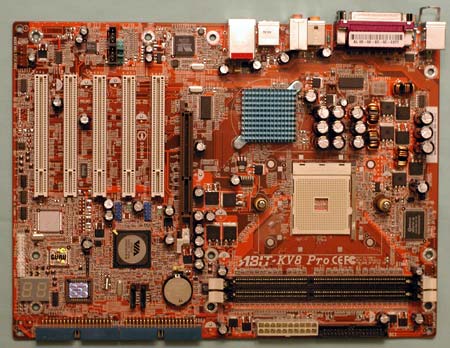
Our first Abit KV8 PRO did not have a working PCI/AGP lock. However, Abit quickly supplied a revised KV8 PRO that definitely does have a working PCI/AGP lock. We tested the revised KV8 Pro with PCI Geiger and the lock is definitely working on the revised KV8 PRO. However, there were no ratio adjustments at all in the Abit BIOS, an amazing oversight from a company that caters to the overclocker. The KV8 PRO also had the strange behavior of booting at a 9X ratio, when our 3200+ is a 10X ratio processor. Abit Engineers are aware of these issues and assure us that they will definitely be fixed on shipping boards.
The Abit KV8 PRO actually runs at 204FSB when the frequency is set to 200. Fortunately, Abit shows this modest overclock in uGuru and we were able to adjust the FSB to 200 for testing.
The Abit KV8 PRO has tremendous potential, but it is plagued with annoying BIOS problems. When these are ironed out, it will likely be one of the top Socket 754 boards, but these issues prevented a real test of the capabilities of the KV8 PRO.
Abit KV8 PRO: Overclocking and Stress Testing
FSB Overclocking Results
| Front Side Bus Overclocking Testbed | |
| Default Voltage | |
| Processor: | Athlon 64 3200+ 2.0GHz |
| CPU Voltage: | 1.5V (default) |
| Cooling: | AMD Stock Athlon 64 Heatsink/Fan |
| Power Supply: | Antec TruePower 430W |
| Maximum OC: (Standard Ratio) |
248FSB x10 2480MHz (+24%) |
| Maximum FSB: (Lower Ratio) |
No Ratios Available |
This late 3200+ achieved about the same outstanding overclock on the Abit K8V PRO that we saw in our review of the K8N Neo Platinum. The Abit reached 248FSB at the stock 10X multiplier and default voltage. However, to even test the stock 10X multiplier, we had to force the Abit to 10X with the free Clock Generator utility from www.cpuid.com. This 24% overclock at stock multiplier suggests that our late 3200+ is coming from improved yields on the AMD production line for Athlon 64. If this is really the case, it is very good news for overclocking enthusiasts.
We were not able to test the highest FSB that could be achieved by lowering the multiplier, since no ratio adjustments were available on the Abit. Multipliers on Athlon 64 chips are unlocked at ratios below the shipping multiplier. This is primarily a result of the Cool'n'Quiet feature according to AMD, and AMD refers to this as Athlon 64 processors being "downclockable". FX chips are completely unlocked, and can be set at either higher or lower ratios than stock. Abit tells us that they will add ratios to a future BIOS, and they are working on a BIOS revision to correct the problem with the incorrect boot ratio. By using Clock Gen, we were able to verify that the KV8 PRO could reach 275 1:1 at an 8X multiplier with a DDR550 DIMM.
Memory Stress Test Results:
The memory stress test is very basic, as it tests the ability of the Abit KV8 PRO to operate at its officially supported memory frequency (400MHz DDR), at the best performing memory timings that our Mushkin PC3500 Level 2 or OCZ PC3500 Platinum Ltd Modules will support. Memory stress testing was conducted by running RAM at 400MHz with 2 DIMM slots filled. However, please keep in mind that Socket 754 is single-channel and will still operate at top speed with just one DIMM.| Stable DDR400 Timings - 2 DIMMs (2/2 DIMMs populated) |
|
| Clock Speed: | 200MHz |
| Timing Mode: | N/A |
| CAS Latency: | 2.0 |
| Bank Interleave: | N/A |
| RAS to CAS Delay: | 2T |
| RAS Precharge: | 10T (10T for Best Performance)* |
| Precharge Delay: | 2T |
| Command Rate: | 1T |
*Several memory tests have shown that memory performs fastest on the nVidia nForce and VIA K8T800 chipsets at a TRas (RAS Precharge) setting in the 9 to 13 range. We ran our own Memory Bandwidth tests with memtest86 with TRas settings from 5 to 15 at a wide range of different memory speeds. The best bandwidth was consistently at 9 to 11 at every speed, with TRas 10 always in the best range at every speed. The memory bandwidth improvement at TRas 10 was only 2% to 4% over TRas 5 and 6 depending on the speed, but the performance advantage was consistent across all tests. Since best performance was achieved at 2-2-2-10 timings, all Athlon 64 benchmarks were run at a TRas setting of 10.
The Abit KV8 PRO was completely stable with 2 DIMMs at the best performing settings of 2-2-2-10 at default speed. Higher overclocks could be achieved with 1 DIMM compared to 2 DIMMs, but at default speed, 1 or 2 DIMMs were reliable at the same aggressive 2-2-2-10 timings.
Abit had no adjustments at all for Bank Interleave or Command Rate, but the Command Rate is likely set to 1T. We have been discovering that Command Rate is very important to performance of Athlon 64 Dual channel memory and it should be set to 1T if possible for best performance.
Chaintech VNF3-250: Features and Layout
| Motherboard Specifications | |
| CPU Interface | Socket 754 Athlon 64 |
| Chipset | nVidia nForce3-250 |
| CPU Ratios | 6 to 22 in 1X increments |
| Bus Speeds | 200MHz to 400MHz (in 1MHz increments) |
| PCI/AGP Speeds | Auto, 66MHz to 85MHz (in 1MHz increments) |
| HyperTransport | 1x-5x (200MHz to 1GHz) |
| Core Voltage | 1.45V-1.70V in .025V increments to 1.55V and .05V increments 1.6V to 1.7V |
| DRAM Voltage | 2.5V to 2.9V in 0.1V increments |
| AGP Voltage | 1.5V to 2.2V in 0.1V increments |
| Chipset Voltage | 1.6V to 1.9V in 0.1V increments |
| Memory Slots | Three 184-pin DDR DIMM Slots Unbuffered Memory to 2GB Total |
| Expansion Slots | 1 AGP 8X Slot 5 PCI Slots 1 CMR (Chaintech Multimedia Riser) Slot |
| Onboard SATA/RAID | nVidia 2-Drive SATA by nF3-250 SATA can be combined in RAID 0, 1, JBOD |
| Onboard IDE | Two Standard nVidia ATA133/100/66 (4 drives) |
| Onboard USB 2.0/IEEE-1394 | 8 USB 2.0 ports supported by nF3-250 No FireWire ports |
| Onboard LAN | 10/100 Ethernet Realtek RTO8100C PCI |
| Onboard Audio | CMedia CM19761A 6-Channel with SPDIF |
Chaintech motherboards are best known for their top-of-the-line Zenith series, which include coordinated cables, front break-out boxes, and every motherboard accessory that you could imagine. The other top Chaintech feature is a very complete selection of overclocking and control options for the Enthusiast. With that in mind, you may not be surprised to see the complete selection of Voltage and Frequency adjustments. However, you may be shocked when you realize that this kind of control is available on a motherboard designed to sell for less than $100.
The VNF3-250 is the first Zenith Value Edition motherboard. We are told that the Zenith Value Edition boards are designed to provide top-notch features for the Enthusiast and Overclocker, but without all the add-ons and frills that drive up the price. Based on that philosophy, Chaintech has certainly succeeded in reaching their target with the VNF3-250.
There are some compromises in order to reach the "under $100" price goal. Chaintech uses the nF3-250 chipset rather than the more expensive nF3-250Gb, and therefore has eliminated the on-chip Gigabit LAN and nVidia on-chip Firewall. Instead, 10/100 LAN is provided with a Realtek PCI chip. RAID is of the 2-drive SATA variety and is not the 8-drive "any-drive" IDE/RAID solution found on top-line nForce3-250Gb boards. Also, you will not find any Firewire ports on the VNF3-250, but these can be added with a PCI card if you need them. Everything else, however, is here on the Chaintech and the performance that we found with this board in our review of OCZ3700 was simply outstanding.
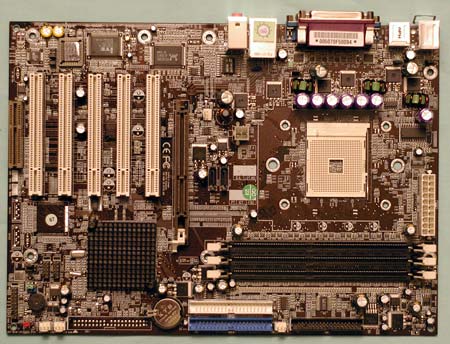
The VNF3-250 is a little smaller than full ATX, but nothing is cramped at all on the board. It is also worth pointing out that Chaintech, unlike most others building to a price point, still delivers a 3-phase power design. This attention to detail pays off in the great performance that we found with the Chaintech.
Chaintech VNF3-250: Overclocking and Stress Testing
FSB Overclocking Results
| Front Side Bus Overclocking Testbed | |
| Default Voltage | |
| Processor: | Athlon 64 3200+ 2.0GHz |
| CPU Voltage: | 1.5V (default) |
| Cooling: | AMD Stock Athlon 64 Heatsink/Fan |
| Power Supply: | Antec TruePower 430W |
| Maximum OC: (Standard Ratio) |
246FSB x10 2460MHz (+23%) |
| Maximum FSB: (Lower Ratio) |
275FSB x 8 at 1:1 Memory |
The benefit of the working PCI/AGP lock on the nForce3-250 chipset is obvious. This late 3200+ reached the same 246-248 overclock that we have seen on other nF3-250 motherboards with this late 3200+. This 23% overclock at stock multiplier is more like those that we are accustomed to seeing on Pentium 4.
The Maximum FSB test deserves a bit of explanation. Our goal here was to find the highest FSB that we could achieve in synchronous mode (or 1:1) with a single DDR550 DIMM that has reached DDR570 (285FSB setting) on a Pentium 4 test platform with an Intel ES processor and unlocked multipliers. Since it is not possible to test everything in a roundup, we did not test asynchronous operation, which would be running the memory at a lower speed than the bus. Asynchronous mode is possible on all 5 of these motherboards, and it may be possible to achieve even higher FSB settings by removing memory speed as a limitation.
With a single DIMM of OCZ DDR4400EL, the best FSB that we could achieve at a 1:1 ratio was a stable 275 or DDR550, at a ratio of 8. HyperTransport could be maintained at the 4X (800 setting) up to a 260 to 265 FSB setting. Above this point to the maximum of 275FSB at 1:1, we needed a 3X HT setting.
Memory Stress Test Results:
The memory stress test measures the ability of the Chaintech VNF3-250 to operate at its officially supported memory frequency (400MHz DDR), at the best performing memory timings that our Mushkin PC3500 Level 2 or OCZ PC3500 Platinum Ltd Modules will support. Memory stress testing was conducted by running RAM at 400MHz with 2 DIMM slots filled. However, please keep in mind that Socket 754 is single-channel and will still operate at top speed with just one DIMM.| Stable DDR400 Timings - 2 DIMMs (2/3 DIMMs populated) |
|
| Clock Speed: | 200MHz |
| Timing Mode: | N/A |
| CAS Latency: | 2.0 |
| Bank Interleave: | N/A |
| RAS to CAS Delay: | 2T |
| RAS Precharge: | 10T (10T for Best Performance)* |
| Precharge Delay: | 2T |
| Command Rate: | N/A |
*Several memory tests have shown that memory performs fastest on the nVidia nForce and VIA K8T800 chipsets at a TRas (RAS Precharge) setting in the 9 to 13 range. We ran our own Memory Bandwidth tests with memtest86 with TRas settings from 5 to 15 at a wide range of different memory speeds. The best bandwidth was consistently at 9 to 11 at every speed, with TRas 10 always in the best range at every speed. The memory bandwidth improvement at TRas 10 was only 2% to 4% over TRas 5 and 6 depending on the speed, but the performance advantage was consistent across all tests. Since best performance was achieved at 2-2-2-10 timings, all Athlon 64 benchmarks were run at a TRas setting of 10.
The Chaintech VNF3-250 was completely stable with 2 DIMMs at the best performing settings of 2-2-2-10 at default speed. Higher overclocks could be achieved with 1 DIMM compared to 2 DIMMs, but at default speed, 1 or 2 DIMMs were reliable at the same aggressive 2-2-2-10 timings. Filling all three available memory slots is more strenuous on the memory subsystem than testing 2 DIMMs on a motherboard.
| Stable DDR400 Timings - 3 DIMMs (3/3 DIMMs populated) |
|
| Clock Speed: | 200MHz |
| Timing Mode: | N/A |
| CAS Latency: | 2.0 |
| Bank Interleave: | N/A |
| RAS to CAS Delay: | 2T |
| RAS Precharge: | 10T |
| Precharge Delay: | 2T |
| Command Rate: | N/A |
We were very pleased to find that 3 DS DIMMs (1.5GB) of memory worked fine at the same aggressive timings we used for 2 DIMMs. Even though Chaintech does not recommend running 3 double-sided DIMMs in the VNF3-250, we found the 3 DIMMs worked with complete stability. In fact, this is the first Athlon 64 board we have tested that could run three DS DIMMs at 2-2-2 timings. Most Athlon 64 cannot even run 3 DIMMs, though we are seeing a few nF3-250 boards that can handle 3 DIMMs without a problem.
Epox 8KDA3+: Features and Layout
| Motherboard Specifications | |
| CPU Interface | Socket 754 Athlon 64 |
| Chipset | nVidia nForce3-250Gb |
| CPU Ratios | 8 to 22 in 1X increments |
| Bus Speeds | 200MHz to 350MHz (in 1MHz increments) |
| PCI/AGP Speeds | Auto, 66MHz to 100MHz (in 1MHz increments) |
| HyperTransport | 1x-4x (200MHz to 800MHz) |
| Core Voltage | 1.55V to 1.70V in 0.05V increments |
| DRAM Voltage | 2.5V to 2.8V in 0.1V increments |
| AGP Voltage | 1.5V-1.8V in 0.1V increments |
| Chipset Voltage | 1.60V to 1.75V in 0.05V increments |
| Memory Slots | Three 184-pin DDR DIMM Slots Unbuffered Non-ECC Memory to 2GB Total |
| Expansion Slots | 1 AGP 8X Slot 6 PCI Slots |
| Onboard SATA/RAID | nVidia 2-Drive SATA(RAID 0, 1) Plus SiI3114 4-Drive SATA (RAID 0, 1, 5, 10) |
| Onboard IDE | Two Standard nVidia ATA133/100/66 (4 drives) |
| Onboard USB 2.0/IEEE-1394 | 8 USB 2.0 ports supported by nF3-250 2 1394A FireWire ports by VIA VT6306 |
| Onboard LAN | 1Gigabit Ethernet on-chip by nF3-250GB |
| Onboard Audio | Realtek ALC850 8-Channel with UAJ |
We were very interested in seeing what Epox would do with the nForce3-250 chipset. Epox has a history of building motherboards that are extremely fast with a very wide range of tweaking options. Frankly, while we were impressed with the features that Epox packed in the 8KDA3+, we were quite unimpressed with the mediocre range of tweaking options when we received the Epox. However, Epox persevered and the board improved dramatically over 2 BIOS revisions during our testing. The latest BIOS for the 8KDA3+ provides a very competitive range of tweaking options and it also turns out to be an outstanding performer.

Epox uses their same ugly green trademark for the 8KDA3+, so this is not a board for case modders who demand color coordination. The full-size ATX board is generally well laid out, however, with plenty of room around the CPU for even the largest heatsink/fan. Since this is a board that might find its way into a tower case, we should point out that the floppy and IDE connectors are very low right on board. This is not the best location and will cause a reaching problem in many case designs. Epox is the only board in the roundup with 6 PCI slots, if that is important to you, but the price that you pay for this feature is possibly having to remove very large video cards when you want to change memory. There is also the Epox 2 digit LED trademark that provides diagnostic read-outs to assist in troubleshooting.
Epox does use the latest Gb chipset, so you have both on-chip Gigabit LAN and on-chip Firewall. There are no firewire connections, however, but these can be easily added with a PCI card if you need them. Both Optical and Coaxial SPDIF connectors are handily located on the back IO panel. Epox also has used the Silicon Image SiI3114 controller instead of nVidia's accessory chip. The 3114 supports up to 4 additional SATA drives with standard RAID 0 and 1 plus the option of RAID 5 and 10. RAID 5 and 10 provide options for a Hot Spare and on-line mirror rebuilding to the 4 SATA drives.
Epox 8KDA3+: Overclocking and Stress Testing
FSB Overclocking Results
| Front Side Bus Overclocking Testbed | |
| Default Voltage | |
| Processor: | Athlon 64 3200+ 2.0GHz |
| CPU Voltage: | 1.5V (default) |
| Cooling: | AMD Stock Athlon 64 Heatsink/Fan |
| Power Supply: | Antec TruePower 430W |
| Maximum OC: (Standard Ratio) |
248FSB x10 2480MHz (+24%) |
| Maximum FSB: (Lower Ratio) |
283FSB x 8 at 1:1 Memory |
The working AGP/PCI lock on the nForce3-250 is allowing all our test boards to reach the 246-248 range with this late 3200+. A 24% overclock at stock multiplier is the kind of overclocking performance that many have been looking for since the Athlon 64 was first introduced. Frankly, tests of earlier chips were lucky to reach a 10% overclock, so our results here are no guarantee that your Athlon 64 can achieve this same overclock level.
Dropping the multiplier, and testing 1:1 with one DDR550 DIMM, we achieved the highest 1:1 FSB overclock that we have ever accomplished on an Athlon 64 board at 283FSB or DDR566. This result is as good as we have been able to reach with this same memory on our Intel memory test bed; that speaks well for the stability of the Epox 8KDA3+ design. Epox has done an outstanding job with the BIOS updates for the 8KDA3+. The Epox was not very impressive when we first saw it, but the Epox BIOS magic has turned the 8KDA3+ into a remarkable overclocker.
HyperTransport could be maintained at the 4X (800 setting) up to a 266 FSB setting, which is excellent performance. Above this point to the 1:1 maximum of 283 FSB, we needed a 3X HT setting. We're a little surprised that Epox did not provide a 5X HT setting in BIOS, but even without that option, the Epox 8KDA3+ was an exceptional performer.
Memory Stress Test Results:
The memory stress test is very basic, as it simply tests the ability of the Epox 8KDA3+ to operate at its officially supported memory frequency (400MHz DDR), at the best performing memory timings that our Mushkin PC3500 Level 2 or OCZ PC3500 Platinum Ltd Modules will support. Memory stress testing was conducted by running RAM at 400MHz with 2 DIMM slots filled.| Stable DDR400 Timings - 2 DIMMs (2/3 DIMMs populated) |
|
| Clock Speed: | 200MHz |
| Timing Mode: | N/A |
| CAS Latency: | 2.0 |
| Bank Interleave: | N/A |
| RAS to CAS Delay: | 2T |
| RAS Precharge: | 10T (10T for Best Performance)* |
| Precharge Delay: | 2T |
| Command Rate: | N/A |
*Several memory tests have shown that memory performs fastest on the nVidia nForce and VIA K8T800 chipsets at a TRas (RAS Precharge) setting in the 9 to 13 range. We ran our own Memory Bandwidth tests with memtest86 with TRas settings from 5 to 15 at a wide range of different memory speeds. The best bandwidth was consistently at 9 to 11 at every speed, with TRas 10 always in the best range at every speed. The memory bandwidth improvement at TRas 10 was only 2% to 4% over TRas 5 and 6 depending on the speed, but the performance advantage was consistent across all tests. Since best performance was achieved at 2-2-2-10 timings, all Athlon 64 benchmarks were run at a TRas setting of 10.
The original BIOS of the Epox 8KDA3+ was rock solid with one DIMM, but not very stable with two DIMMs - requiring slower timings. The latest BIOS greatly improves the Epox memory performance, allowing the same aggressive timings with 2 DIMMs that we could use with one DIMM.
Filling all three available memory slots is more strenuous on the memory subsystem than testing 2 DIMMs on a motherboard. Epox does not recommend using 3 double-sided DIMMs, and in this case, it is solid advice. No matter what we tried, or how slow the timings we set, 3 double-sided DIMMs would not operate in the 8KDA3+. We do not consider the inability to run 3 DS DIMMs a real handicap on a Single-Channel memory motherboard, but if this is an important feature to you, the Epox is not the motherboard to run 3 DIMMs. Despite the fact that 3 DS DIMMs are not officially supported on the nForce3-250, the other nF3-250 boards did manage to run 3 DIMMs, some at the same aggressive timings used for 2 DIMMs.
Gigabyte K8NSNXP: Features and Layout
| Motherboard Specifications | |
| CPU Interface | Socket 754 Athlon 64 |
| Chipset | nVidia nForce3-250 |
| CPU Ratios | 4 to 25 in 0.5X increments |
| Bus Speeds | 200MHz to 455MHz (in 1MHz increments) |
| PCI/AGP Speeds | Auto, 66MHz to 100MHz (in 1MHz increments) |
| Core Voltage | 0.80V to 1.7V in 0.025V increments |
| DRAM Voltage | Normal, +0.1V, +0.2V |
| VDDQ (Chipset)Voltage | Normal, +0.1V, +0.2V, +0.3V |
| HT (HyperTransport) Voltage | Normal, +0.1V, +0.2V, +0.3V |
| Memory Slots | Three 184-pin DDR DIMM Slots Unbuffered Non-ECC Memory to 2GB Total |
| Expansion Slots | 1 AGP 8X Slot 5 PCI Slots |
| Onboard SATA/RAID | nVidia 2-Drive SATA (RAID 0, 1, JBOD) Plus 2-Drive SiI3512 (RAID 0, 1, JBOD) |
| Onboard IDE/RAID | Two nVidia ATA133/100/66 (4 drives) PLUS 4-drive IT8212 GigaRAID RAID 0, 1, 0+1) |
| Onboard USB 2.0/IEEE-1394 | 8 USB 2.0 ports supported by nF3-250 3 1394B FireWire ports by VIA VT6306 |
| Onboard LAN | 1Gigabit Ethernet by Marvel 8001 PCI 10/100Ethernet by ICS1883 |
| Onboard Audio | Realtek ALC850 8-Channel with SPDIF |
The Gigabyte K8NSNXP offers some of the widest adjustment ranges and the most complete feature set of any board in this roundup. Gigabyte has promoted the Dual capability in almost all their recent high-end boards, and the K8NSNXP continues that tradition. The trademark DPS card boosts power regulation to 6-phase for stability, SATA has both nVidia and Silicon Image controllers, IDE features nVidia regular IDE plus ITE GigaRAID, Audio is 8-channel, and there are even two LAN connectors. However, despite the incredibly long feature list for this top-end board, the system is still based on the nForce3-250 chipset and not the nForce3-250Gb. That means neither LAN is on-chip (they both appear to be tied to the PCI bus), and the nVidia Firewall is not a feature on the Gigabyte.

Gigabyte builds extremely solid motherboards, and this certainly shows in the construction of this clear-blue, full-size ATX motherboard with rounded corners. Attention to detail also shows in the almost ideal placement of components on the K8NSNXP, with IDE, Floppy, ATX 20-pin and 12V connectors all at near ideal locations. The only real complaint about layout is that the DPS card blocks air flow from a down-facing fan on the Power Supply when it is installed.
For those looking for great Firewire support, the Gigabyte comes through again with 3 1394B high-speed Firewire ports. Gigabyte has been supplying 1394B on its top motherboards for some months, and that continues with the K8NSNXP. Gigabyte also provides quiet active cooling for the single chip nForce3-250. On-board headers are also located for easy connection of front ports if that is a feature of your case.
Gigabyte K8NSNXP: Overclocking and Stress Testing
FSB Overclocking Results
| Front Side Bus Overclocking Testbed | |
| Default Voltage | |
| Processor: | Athlon 64 3200+ 2.0GHz |
| CPU Voltage: | 1.5V (default) |
| Cooling: | AMD Stock Athlon 64 Heatsink/Fan |
| Power Supply: | Antec TruePower 430W |
| Maximum OC: (Standard Ratio) |
242FSB x10 2420MHz (+21%) (246 with EZTune4) |
| Maximum FSB: (Lower Ratio) |
242FSB x 10 at 1:1 Memory (275x8.5 at 1:1 with EZTune4) |
On paper, the Gigabyte K8NSNXP should be an incredible performer, but we found that no matter what we did, the Gigabyte would not boot at any ratio, at a speed higher than a BIOS setting of 242. This seems to be an artificial boot limiter, since we were able to reach a very competitive 275x8.5 using EZTune4 in Windows XP. While we were happy to see this level of performance with EZTune4, it is still a much less convenient method of overclocking than tuning the same settings in BIOS. EZTune4 does allow settings to be saved, so Windows will load at the same overclock on reboot, but we really wish that Gigabyte would give us a choice on how we wish to overclock. Gigabyte has been using what appears to be BIOS boot limits on several recent boards, probably to limit the number of boards destroyed by indiscriminate overclock settings in BIOS. We do understand why, but we still prefer to dial our own, as do most other overclockers.
The other complaint with recent Gigabyte boards is the extremely limited range of memory voltage adjustments that are provided. Memory is now available that is warranted to 3.0V to 3.2V, and an adjustment of just +0.2V for vDIMM is just not enough for some memory. The Chipset and HT voltage adjustments partially offset this limitation, but they are not an adequate substitute for such a limited selection of vDIMM settings. Gigabyte builds very reliable motherboards, and with a little more attention to memory voltage and BIOS overclocking, they would consistently be at or near the top in every roundup.
Memory Stress Test Results:
The memory stress test simply checks the ability of the Gigabyte K8NSNXP to operate at its officially supported memory frequency (400MHz DDR), at the best performing memory timings that our Mushkin PC3500 Level 2 or OCZ PC3500 Platinum Ltd Modules will support. Memory stress testing was conducted by running RAM at 400MHz with 2 DIMM slots filled.| Stable DDR400 Timings - 2 DIMMs (2/3 DIMMs populated) |
|
| Clock Speed: | 200MHz |
| Timing Mode: | N/A |
| CAS Latency: | 2.0 |
| Bank Interleave: | N/A |
| RAS to CAS Delay: | 2T |
| RAS Precharge: | 10T (10T for Best Performance)* |
| Precharge Delay: | 2T |
| Command Rate: | N/A |
*Several memory tests have shown that memory performs fastest on the nVidia nForce and VIA K8T800 chipsets at a TRas (RAS Precharge) setting in the 9 to 13 range. We ran our own Memory Bandwidth tests with memtest86 with TRas settings from 5 to 15 at a wide range of different memory speeds. The best bandwidth was consistently at 9 to 11 at every speed, with TRas 10 always in the best range at every speed. The memory bandwidth improvement at TRas 10 was only 2% to 4% over TRas 5 and 6 depending on the speed, but the performance advantage was consistent across all tests. Since best performance was achieved at 2-2-2-10 timings, all Athlon 64 benchmarks were run at a TRas setting of 10.
The Gigabyte K8NSNXP was completely stable with 2 DIMMs at the best performing settings of 2-2-2-10 at default speed, but we did need to boost memory voltage slightly by +0.1V for best stability. Higher overclocks could be achieved with 1 DIMM compared to 2 DIMMs, but at default speed, 1 or 2 DIMMs were reliable at the same aggressive 2-2-2-10 timings.
Filling all three available memory slots is more strenuous on the memory subsystem than testing 2 DIMMs on a motherboard. As we found on most other nF3-250 boards, 3 DS DIMMs (1.5GB) of memory worked fine at timings almost the same as the aggressive timings that we used for 2 DIMMs.
| Stable DDR400 Timings - 3 DIMMs (3/3 DIMMs populated) |
|
| Clock Speed: | 200MHz |
| Timing Mode: | N/A |
| CAS Latency: | 2.0 |
| Bank Interleave: | N/A |
| RAS to CAS Delay: | 3T |
| RAS Precharge: | 10T |
| Precharge Delay: | 2T |
| Command Rate: | N/A |
Three DIMMs required 2-2-3-10 timings for stable operation, but they remained stable at the +0.1V memory voltage that was required with 2 DS DIMMs. 2-2-3 is very close to the best performing 2-2-2-10 timings with 2 dimms.
MSI K8N Neo Platinum: Features and Layout
| Motherboard Specifications | |
| CPU Interface | Socket 754 Athlon 64 |
| Chipset | nVidia nForce3-250Gb |
| CPU Ratios | 4 to Default Ratio in 1X increments |
| Bus Speeds | 200MHz to 300MHz (in 1MHz increments) |
| PCI/AGP Speeds | Auto, 66MHz to 100MHz (in 1MHz increments) |
| Core Voltage | Default to 1.81V in % increments (with 1.50V 1.57V, 1.60V, 1.65V, 1.68V, 1.73V, 1.76V, 1.81V) |
| DRAM Voltage | Auto, 2.5V to 2.85V in 0.05V increments |
| AGP Voltage | 1.5V-1.85V in 0.05V increments |
| AUTO Overclock | D.O.T. Ranger, 1%, 3%, 5%, 7%, 9%, 11% |
| Memory Slots | Three 184-pin DDR DIMM Slots Unbuffered Non-ECC Memory to 2GB Total |
| Expansion Slots | 1 AGP 8X Slot 5 PCI Slots |
| Onboard SATA/IDE RAID | nVidia 4-Drive SATA Plus 4-Drive IDE IDE/SATA can be combined in 0, 1, 0+1 |
| Onboard IDE | Two Standard nVidia ATA133/100/66 (4 drives) |
| Onboard USB 2.0/IEEE-1394 | 8 USB 2.0 ports supported by nF3-250 2 1394A FireWire ports by VIA VT6306 |
| Onboard LAN | 1Gigabit Ethernet on-chip by nF3-250GB |
| Onboard Audio | Realtek ALC850 8-Channel with UAJ |
You can read more about the MSI nForce3-250Gb in our full review of the K8N Neo Platinum. Charts have been included to make it easier to compare features and performance of the MSI to other 2nd generation Socket 754 motherboards.
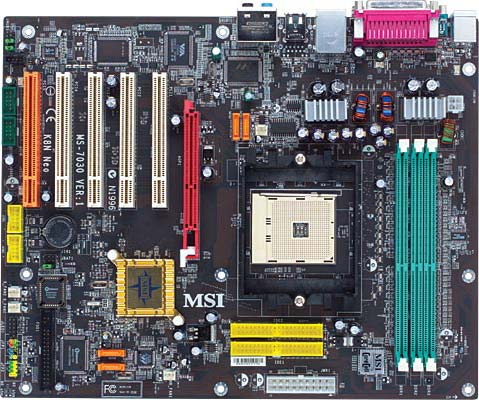
MSI K8N Neo Platinum: Overclocking and Stress Testing
FSB Overclocking Results
| Front Side Bus Overclocking Testbed | |
| Default Voltage | |
| Processor: | Athlon 64 3200+ 2.0GHz |
| CPU Voltage: | 1.5V (default) |
| Cooling: | AMD Stock Athlon 64 Heatsink/Fan |
| Power Supply: | Antec TruePower 430W |
| Maximum OC: (Standard Ratio) |
246FSB x10 2460MHz (+23%) |
| Maximum FSB: (Lower Ratio) |
270FSB x 7 at 1:1 Memory |
You can read more about the MSI nForce3-250Gb in our full review of the K8N Neo Platinum. Charts have been included to make it easier to compare features and performance of the MSI to other 2nd generation Socket 754 motherboards.
Memory Stress Test Results:
| Stable DDR400 Timings - 2 DIMMs (2/3 DIMMs populated) |
|
| Clock Speed: | 200MHz |
| Timing Mode: | N/A |
| CAS Latency: | 2.0 |
| Bank Interleave: | N/A |
| RAS to CAS Delay: | 2T |
| RAS Precharge: | 10T (10T for Best Performance)* |
| Precharge Delay: | 2T |
| Command Rate: | N/A |
*Several memory tests have shown that memory performs fastest on the nVidia nForce and VIA K8T800 chipsets at a TRas (RAS Precharge) setting in the 9 to 13 range. We ran our own Memory Bandwidth tests with memtest86 with TRas settings from 5 to 15 at a wide range of different memory speeds. The best bandwidth was consistently at 9 to 11 at every speed, with TRas 10 always in the best range at every speed. The memory bandwidth improvement at TRas 10 was only 2% to 4% over TRas 5 and 6 depending on the speed, but the performance advantage was consistent across all tests. Since best performance was achieved at 2-2-2-10 timings, all Athlon 64 benchmarks were run at a TRas setting of 10.
| Stable DDR400 Timings - 3 DIMMs (3/3 DIMMs populated) |
|
| Clock Speed: | 200MHz |
| Timing Mode: | N/A |
| CAS Latency: | 2.0 |
| Bank Interleave: | N/A |
| RAS to CAS Delay: | 3T |
| RAS Precharge: | 10T |
| Precharge Delay: | 2T |
| Command Rate: | N/A |
Standard Performance Test Configuration
We no longer include Pentium 4 comparisons in our Athlon 64 reviews, since the relative performance of Pentium 4 and Athlon 64 is now well-known. This should make charts comparing Socket 754 motherboards much easier to understand.If you are interested in more information comparing the Athlon 64, Athlon 64 FX, Prescott, P4, and P4EE, please see our in-depth comparisons in the recent FX53/Prescott/3400+ launch reviews:
The Athlon 64 FX-53: AMD's Next Enthusiast Part
Intel's Pentium 4 E: Prescott Arrives with Luggage
Athlon64 3400+: Part 2
AMD's Athlon 64 3400+: Death of the FX-51
Athlon64 3000+: 64-bit at Half the Price
| Performance Test Configuration | |
| Processor(s): | AMD Athlon 64 3200+ (2.0GHz) |
| RAM: | 2 x 512MB Mushkin PC3500 Level II OR 2 x 512MB OCZ PC3500 Platinum Ltd |
| Hard Drive(s): | Seagate 120GB 7200 RPM IDE (8MB Buffer) |
| Video AGP & IDE Bus Master Drivers: | NVIDIA nForce Platform Driver 4.24 (5-10-2004) VIA 4in1 Hyperion 4.51 (12-02-2003) |
| Video Card(s): | ATI Radeon 9800 PRO 128MB (AGP 8X) |
| Video Drivers: | ATI Catalyst 4.5 |
| Operating System(s): | Windows XP Professional SP1 |
| Motherboards: | Abit KV8 PRO (VIA K8T800 PRO) Chaintech VNF3-250 (nVidia nForce3-250) Epox 8KDA3+ (nVidia nForce3-250Gb) Gigabyte K8NSNXP nVidia nForce3-250) MSI K8N Neo (nVidia nForce3-250Gb) nVidia nForc3-250Gb Reference Board |
Tests on Socket 754 Athlon 64 motherboards used either Mushkin PC3500 Level II or OCZ PC3500 Platinum Ltd memory modules. Both memories use Winbond BH5 chips and perform virtually the same in our benchmarks.
All performance tests were run with the ATI 9800 PRO 128MB video card with AGP Aperture set to 128MB with Fast Write enabled. Resolution in all benchmarks is 1024x768x32 unless otherwise noted.
Additions to Performance Tests
PCMark2004 results have been included for comparison. This is in addition to our current standard Veritest Multimedia Content Creation Winstone 2004 and Veritest Business Winstone 2004 for system benchmarking.Game Benchmarks
We have added two new gaming tests to our standard suite of gaming benchmarks. "Return to Castle Wolfenstein - Enemy Within" is a recent OpenGL game based on the Quake engine. We are finding that it is an excellent benchmark for measuring system performance, and it will likely replace Quake3 as our standard OpenGL benchmark down the road. We have also included the Final Fantasy XI benchmark, which is DX9. Other standard game benchmarks include Halo, Microsoft's Direct X 9.0b game; Splinter Cell, a DX9 game; X2 Benchmark, a DX 8.1 game that includes Transform and Lighting effects; the DX9 Aquamark 3; and, Unreal Tournament 2003. The DX 8.1 Comanche 4 benchmark is also used with the 4X anti-aliasing setting to differentiate system performance better using our standard ATI Radeon 9800 PRO video card. We will be reporting more results at 1280 x 1024 resolution in future system and motherboard benchmarking where that resolution provides useful performance data.General Performance and Encoding
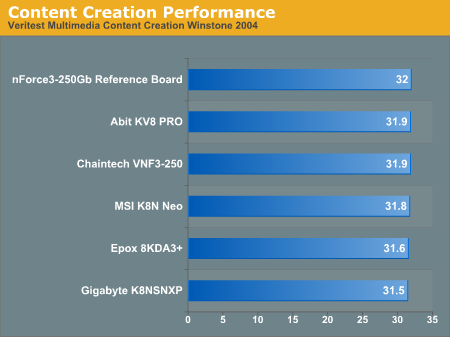
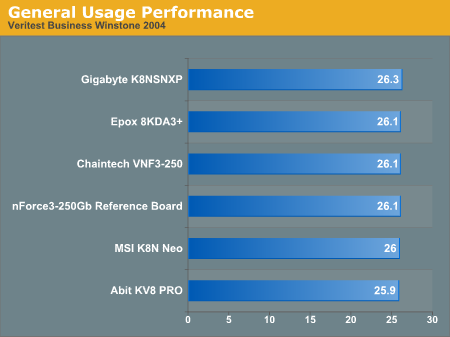
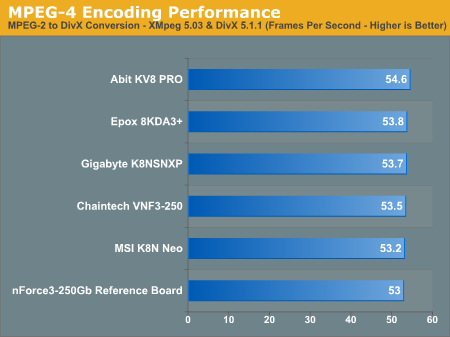
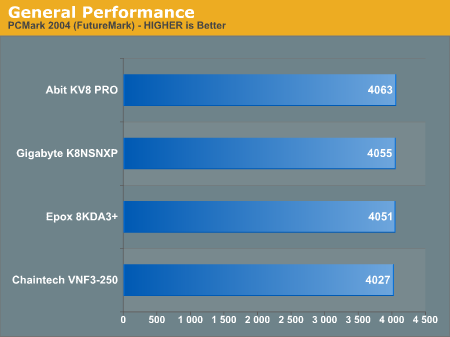
The values are so close together in Multimedia Content Creation and Business Winstone that you can basically conclude that the 5 tested boards are equivalent. There is no way to make a total variation from top to bottom of 0.4 points in Business Winstone or 0.5 points in Multimedia Content Creation significant. This variation represents only a 1.5% difference in the best and worst performance in this suite of 5 second generation Socket 754 boards. PCMark2004 is even more tightly clustered, with the spread from best to worst at only 0.9%.
The 2-pass Media Encoding benchmark also is of little help in differentiating the 5 boards in this roundup. As we have stated in earlier reviews, the on-board memory controller of the Athlon 64 tends to make any differences between boards much smaller than we have seen in the past with the memory controller on the chipset. This is particularly true in overall system performance and encoding benchmarks.
Standard Gaming Performance
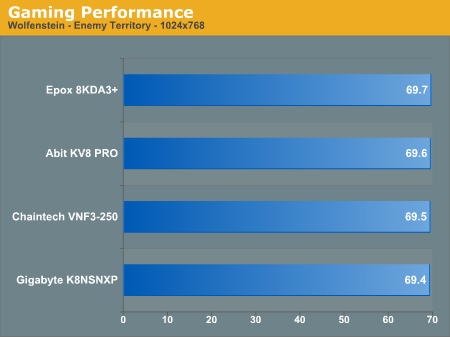
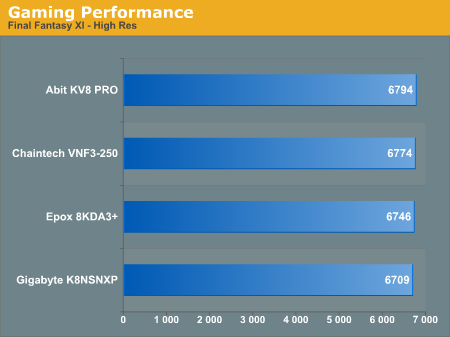
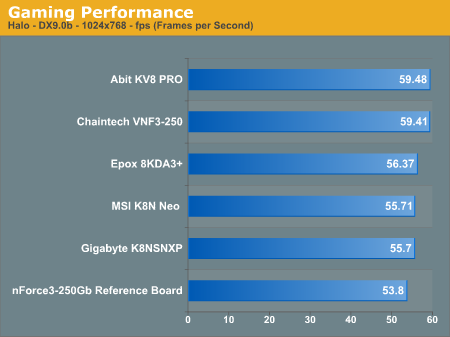
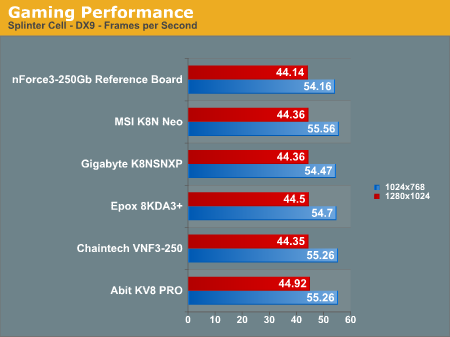
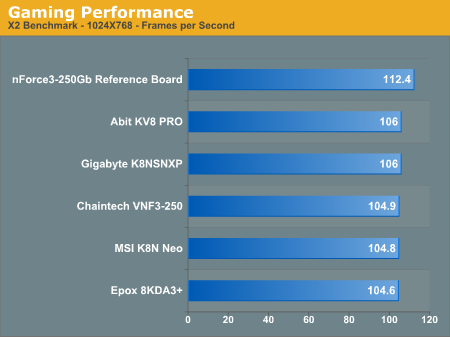
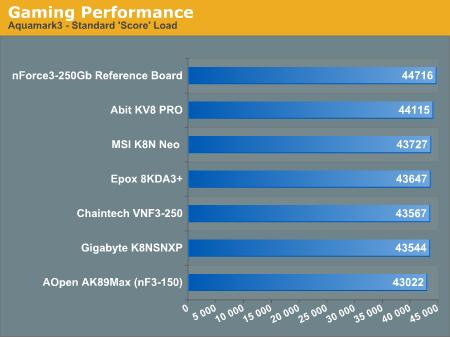
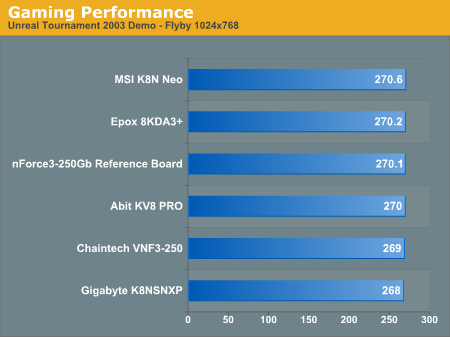
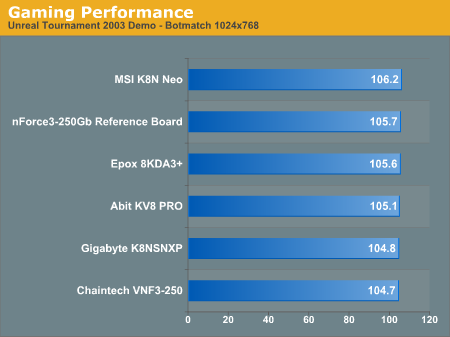

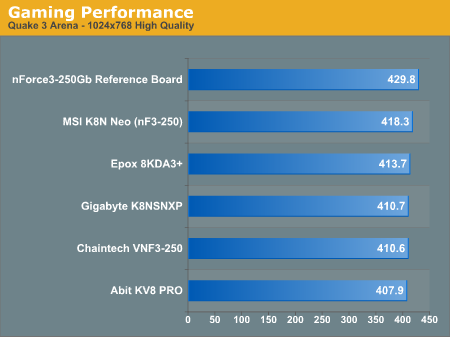
With our stock 3200+ and ATI Radeon 9800 Pro, the results with the 2nd Generation boards are tightly clustered. The MSI, Epox, Chaintech, and Abit boards seem to swap positions in each test, but the difference between gaming performance is just too small to see any single board emerge as the performance champion in this roundup.
Abit's VIA-based KV8 PRO appears to slightly lag the nF3-250 boards in the older Comanche 4 and Quake 3 benchmarks, but it is completely competitive in the newer DX9 games, and one of the best performers in Aquamark3 and Halo.
Standard Workstation Performance

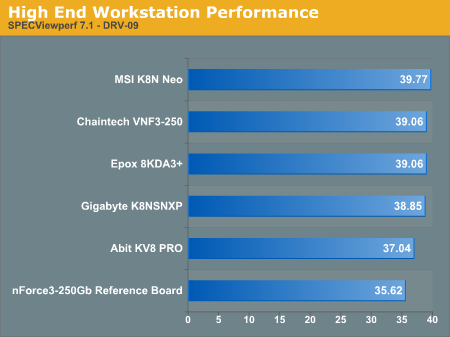
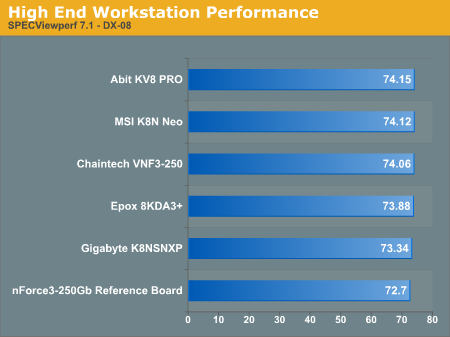

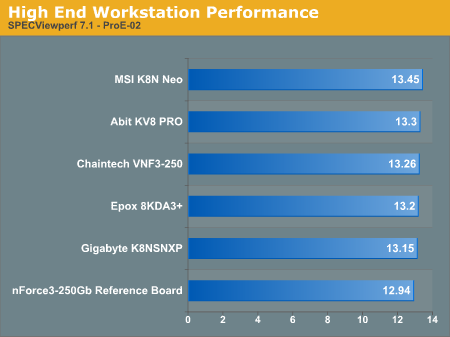
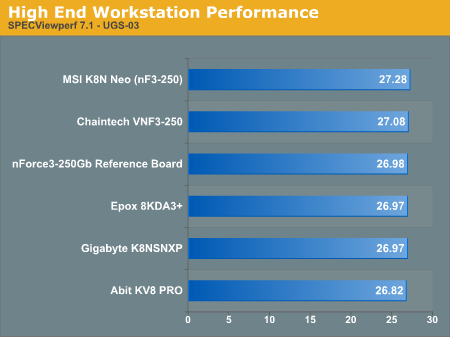
The anomaly in the SPECviewperf suite turned out to be the nVidia Reference board, which we found in our Reference Board review to perform much better in the workstation benchmarks with an nVidia graphics card. Throughout the Reference Board benches, we see the new VIA K8T800 PRO and nVidia nForce3-250 motherboards performing about the same in SPECviewperf with no standout among the 5 new boards. The one interesting result, which we've seen before, is that the VIA chipset performs a bit slower than nVidia in the DRV test. Otherwise, there is little separating the performance of any of the 5 boards.
Some of you might wish for more variation in performance, but while these boards are new with updated chipsets and new features, in general, the chipsets are mature, and the same on-CPU memory controller is being tested in all the benchmarks. This leaves features and the opportunity for increased performance with overclocking as the primary targets for differentiating the 5 boards.
Final Words
As you saw in our benchmark results, there are very little performance differences to differentiate these 5 excellent 2nd generation Socket 754 boards in this roundup. Any of the 5 will make a great home for an Athlon 64 if the only criterion is performance; you won't have to worry much that Ivan down the street has a faster K8T800 PRO motherboard or nForce3-250 motherboard than you do, if you only run at stock speed.However, in the real world, features do matter also, and if we look more closely at these 5, we do see several boards that stand out from the others. Although, all of these 5 motherboards are generally superior to the first generation nForce3-150 and K8T800 in terms of features and flexibility, some certainly out-shine others in the crowd. Both the Epox and the MSI feature the nForce3-250Gb version of nVidia's chipset. We think that the Gb version of nVidia's chipset is definitely an important feature for the on-chip Gigabit LAN, which is removed from the constraints of the PCI bus. nVidia's Firewall is also a useful feature that is only available in the Gb version of the chipset. We believe that the Gb version of the nF3-250 belongs on a high-end motherboard. Despite the fact that it is an incredibly feature-rich board, the Gigabyte K8NSNXP is a top-end motherboard that chooses to use the lower-end nForce3-250 chipset instead of the nForce3-250Gb. The feature set is excellent on the Gigabyte, but it is worth insisting on the Gb version of nForce3-250 if you are paying a premium for an NF3-250 motherboard.
At the other end of the spectrum is the Chaintech VNF-250, which we applaud for using nF3-250 because it is designed to sell for less than $100. It is a board designed to bring dynamite performance to a low price point and it does that very well. Using nF3-250 instead makes sense on a low-end board, and the Chaintech proves that you don't have to give up overclocking or performance if it's done the way it should be.
The other area that differentiates these boards is the included features, and how well they do or don't work. Here, we have to eliminate the Abit KV8 PRO, which is an excellent board otherwise because it is still caught up in teething pains. The 2nd board that we received does have a working PCI/AGP lock, verified by PCI Geiger, but it is still the only board in this roundup without ratios for the CPU. This feature alone makes the working PCI/AGP lock much less useful than it might be otherwise. Also, it strangely boots a 10X CPU at 9X. We are confident that Abit will fix what is wrong with the KV8 PRO. The Abit will likely become an outstanding board, but for now, there are still too many things wrong with the KV8 PRO to recommend it.
This brings us to our last criterion, overclocking performance, in our evaluation of these boards. Here, the Epox and Chaintech stand out as outstanding performers, reaching the highest overclocks that we have seen with great flexibility. The MSI K8N Neo also excelled in this area, but the maximum FSB of 300 is potentially more limiting than the 350 of the Epox or the 400 of the Chaintech. The Gigabyte was also a great performer here, but only if you used EZTune in Windows because the BIOS overclocking of the Gigabyte appears limited purposely to 242. We would have preferred to make the decision ourselves as to whether we would BIOS overclock or EZTune overclock.
 |
Based on features, implementation, value, overclocking performance and flexibility, the Epox 8KDA3+ emerges as our Gold Editors Choice as the top Socket 754 motherboard. Epox has a long history of producing very fast motherboards with excellent overclocking and tweaking features and the 8KDA3+ certainly follows in that tradition. We were very pleased with the excellent feature set of this nF3-250Gb motherboard, and we believe most users will be very happy with the Epox as the building block for their new Athlon 64 system. Users who require Firewire will need to look at another board or plan to use a Firewire card, since it is not included on the Epox. |
Our Silver Editors Choice is a tie between two very different motherboards, the MSI K8N Neo Platinum and the Chaintech VNF-250.
 |
We are extremely pleased to award our Silver Editors Choice to the Chaintech VNF-250 motherboard. As the first in a new Zenith Value Series, we think Chaintech has a great idea - build an overclocker's dream board with all the performance and none of the frills for the lowest possible price. Chaintech also managed to do it without giving up really important features, which is even more commendable. The fact that Chaintech was a top performer in our overclocking tests at a price of less than $100 deserves our award. The VNF-250 proves that you can build a board any enthusiast will want without breaking the bank. Well done, Chaintech. |
 |
The MSI K8N Neo Platinum is a truly excellent motherboard that competes in every way with the best of the Socket 754 motherboards. Its performance is virtually identical to the Epox board, and the feature set is second to none. If Firewire is a requirement, the K8N Neo Platinum belongs at the top of your shopping list. If you want a board that makes top performance easy, then the MSI is also the top choice. Its CoreCell and D.O.T. Ranger auto overclock make the performance of overclocking accessible to even beginners. However, the auto features can be turned off if you like to "roll your own" for top performance. Users will also be pleased with the features that they will find in the box on this high-end Platinum series board. |
Next week will represent the launch of the new Socket 939 processors from AMD. The new Socket 939 chipsets are the same chipsets that you see here: nForce3-250 and K8T800 PRO. The move to Dual-Channel and Socket 939 will be very important to some, but it will not represent the quantum leap in performance that some are expecting. Dual-Channel, after all, did not make a huge difference in the performance of FX and A64 chips when they were the same clock speed with the same cache. What 939 will do is make Dual-Channel more affordable across the board for Athlon 64 processors. It will also make these outstanding 2nd generation Socket 754 boards an even better buy. It will be a very good time to build a new Athlon 64 system - whatever the flavor!







